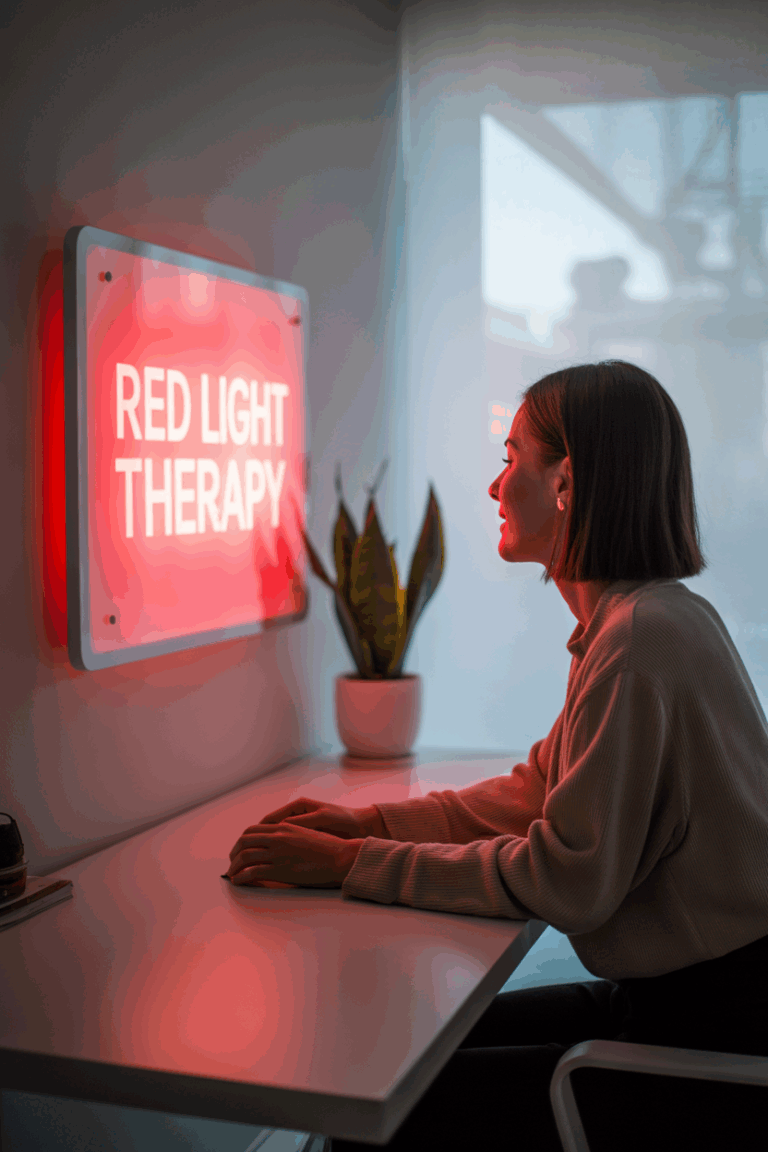Red Light Therapy for Sleep (Fall Faster, Stay Longer)

What Is Red Light Therapy?

Imagine a gentle, warm glow that feels like a cozy hug for your body’s cells. That, in essence, is red light therapy.
It’s a simple, natural way to enhance your self-care routine, bathing your skin in low levels of red and near-infrared light waves.
This is not the disruptive blue light from your phone or the harsh UV radiation from a tanning bed. Instead, think of it as a nourishing superfood for your cells.
Just as plants absorb sunlight to flourish, your cells can soak in these specific light waves. This process can help them perform more efficiently and support your overall wellness journey, a truly fascinating concept.
How Blue Light Disrupts Your Sleep

Deep inside you operates a brilliant 24-hour clock known as your circadian rhythm. Think of it as your body’s internal manager, signaling when to feel alert and when it’s time to wind down for rest.
The most significant cue for this internal clock is light.
Bright light, especially the blue-spectrum light emitted from our phones, laptops, and televisions, effectively shouts “WAKE UP!” at your brain.
When your brain receives this stimulating message late at night, it becomes confused. It then halts the production of melatonin, the wonderful hormone that naturally guides you toward sleep.
Why Red Light Is Your Sleep-Friendly Evening Companion

This is where red light therapy gracefully enters the picture. Unlike its hyperactive blue-light counterpart, red light possesses a longer, gentler wavelength that doesn’t trigger your brain’s “daytime” alert system.
Using a soft red light during your evening routine helps maintain a sleep-friendly environment. It allows your body to wind down naturally, just as it’s meant to do.
Scientific studies confirm that this type of light does not interfere with crucial melatonin production.
This quality makes it a fantastic addition to any nighttime ritual aimed at improving sleep and relaxation.
Does Red Light Therapy Really Improve Sleep?

Let’s dive into the science behind this gentle therapy. The growing body of research on red light for sleep is showing incredible promise.
For example, one compelling study focused on female athletes. It found that just 30 minutes of red light therapy each night for two weeks measurably improved their sleep quality and boosted their melatonin levels.
This finding is exciting, and it’s supported by other studies showing similar benefits for sleep.
It’s also important to acknowledge that the scientific community is still exploring the full potential of this therapy, so individual results can vary.
However, the overwhelmingly positive findings make red light therapy a wellness practice worth getting curious about.
How a Restful Ritual Can Signal Bedtime

Beyond the compelling science, the simple act of using red light can become a beautiful ritual to close your day. It’s a practice rooted in the psychology of winding down, creating a clear transition to rest.
Taking 10 to 20 minutes for yourself is a powerful, non-verbal cue to your brain. It signals that the day’s obligations are complete and it’s time to prepare for sleep.
This ritual creates a peaceful boundary between the demands of your day and your quiet time for restoration. It helps you mentally and physically disconnect from stress.
It’s a conscious moment to transition from a state of “doing” to one of simply “being,” which is essential for deep relaxation and a peaceful night’s sleep. Your bedtime ritual should be a cherished part of your overall sleep hygiene.
How to Weave Red Light Therapy into Your Evening

Adding this gentle practice to your nightly routine is simple. It seamlessly integrates into the quiet moments before bed.
The standard recommendation, consistent with many research protocols, is to relax near a red light device for 10 to 20 minutes.
Aim to have your session about 30 to 60 minutes before you plan to be asleep for the night.
You don’t need to do anything special during this time. Simply let the warm light shine on you while you read a paper book, meditate, stretch gently, or listen to calming music. It’s your time to unwind.
What Kind of Red Light Device Should You Get?

A wonderful variety of at-home red light therapy devices are now available. You can easily find one that fits your space and lifestyle.
Options range from large panels that offer a full-body spa experience to smaller, stylish lamps perfect for a nightstand. There are even targeted masks if you prefer a more focused application.
While they may look different, all these devices share the same core purpose. They are designed to deliver beneficial red and near-infrared light to support your well-being.
For sleep benefits specifically, look for devices that provide light within the therapeutic range of 630-670 nanometers (nm).
Is At-Home Red Light Therapy Safe?

For most healthy individuals, using an at-home red light device is considered very safe. The key is to always follow the manufacturer’s instructions.
These devices are UV-free, so you can rest assured you are not getting any of the skin-damaging radiation associated with sun exposure.
It is always wise to avoid staring directly into the lights—a simple, common-sense precaution.
Sticking to the suggested session times will ensure you get the benefits without overdoing it. Overall, it’s a wonderfully safe and natural way to support your nightly wind-down.
Build Your Sleep “Dream Team” with Healthy Habits

To achieve the best results, think of red light therapy as one valuable player on your sleep “dream team.” It performs best when paired with other proven healthy sleep habits.
Your first all-star habit is maintaining a consistent schedule. Try to go to bed and wake up around the same time each day, even on weekends.
Next, make your bedroom a sleep sanctuary. Keep it a cool, dark, and quiet cave designed purely for rest.
Pay attention to what you consume in the evening. Avoid that late-afternoon espresso or a large, heavy meal close to bedtime.
Finally, create a relaxing, screen-free wind-down hour before bed. This reduces your exposure to stimulating blue light and helps quiet a busy mind.
Why Patience and Consistency Are So Important

Remember that every body, and everybody, is different. Some people might notice a sense of evening calm almost immediately after starting red light therapy.
For others, the positive changes may be more gradual. The sleep-enhancing effects often build slowly over time with regular use.
We would all love a magic button for perfect sleep, and while this isn’t quite that, it’s a healthy habit with compounding benefits.
Just like with exercise or healthy eating, consistency is your greatest ally. Give the practice a few weeks of dedicated use to truly see how your body responds.
How Red Light Therapy Protects Your Natural Melatonin

One of the most remarkable aspects of red light therapy is how it respects your body’s natural rhythm. It works with your biology, not against it.
We know that blue light from screens can act like a roadblock to your body’s melatonin production, effectively shutting it down.
Red light therapy is the complete opposite. Its gentle wavelengths do not block melatonin synthesis, which is a major victory for your natural sleep cycle.
While some early studies hint that it might encourage your cells to produce melatonin more effectively, the evidence is still emerging. The most crucial takeaway is that red light is a “melatonin-friendly” light source, helping to protect your innate sleep process.
When Should You Consult a Doctor About Sleep?

Basking in a warm, red glow is a fantastic self-care tool to enhance your wellness routine. However, it is not a medical treatment for serious sleep disorders.
If you have ongoing, significant trouble with sleep, it is always wise to chat with your doctor. A professional can help you get to the root of the problem.
Conditions like chronic insomnia or sleep apnea require a medical diagnosis and a comprehensive treatment strategy.
Think of red light therapy as a supportive habit for better sleep hygiene, while your doctor is your partner for diagnosing and treating underlying health conditions.






